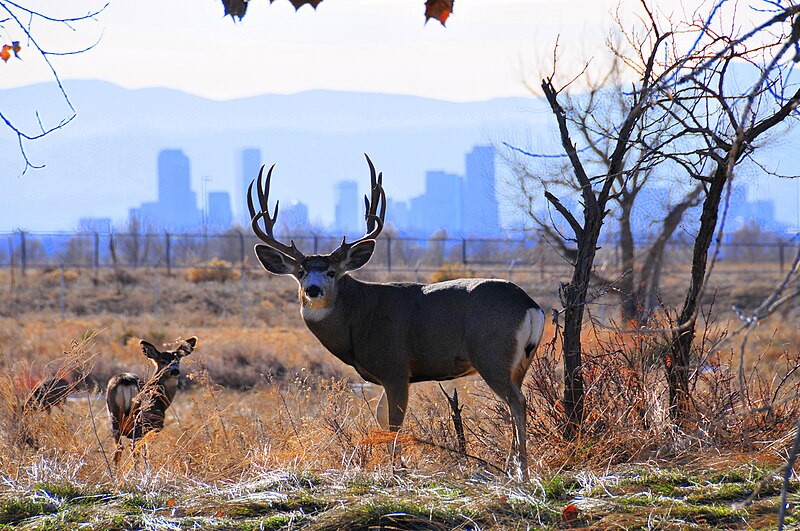Disappearing Mule Deer A New Reality Throughout Western U.S.
Scientists throughout the West are trying to figure out the mystery of the disappearing mule deer. Since the 1970s, biologists in Colorado, Wyoming and Utah have seen deer populations drop by 50 percent. The potential causes vary. Oil and gas development and the growth in coyote populations top the list.
.
ROBERT SIEGEL, HOST: From NPR News, this is ALL THINGS CONSIDERED. I'm Robert Siegel.
AUDIE CORNISH, HOST:
And I'm Audie Cornish. Scientists throughout the west are investigating a mysterious disappearance. Mule deer are vanishing. In Colorado, Wyoming and Utah, populations are half what they were in the 1970s. From Aspen Public Radio, Luke Runyon reports on some possible reasons.
LUKE RUNYON, BYLINE: When John Hilandras(ph) was just a boy growing up on his family's ranch in the northwest corner of Colorado, his father would take him deer hunting. Back then, it wasn't even a challenge.
Mule Deer hemmed in by the works of Humanity

JOHN HILANDRAS: We had literally thousands of deer. There was just deer everywhere. It seemed like they were like rabbits.
RUNYON: That's not the case today. Mule deer throughout the West are becoming more and more scarce. Hilandras runs his own outfitting business out of his family ranch. His customers used to bring back 12-point bucks, no problem. Now, weeks will go by before he sees a prize-winning animal.
HILANDRAS: In good conscience, a good ethical outfitter offering a trophy deer hunt should be careful 'cause it's not like it was.
RUNYON: About a dozen researchers huddle on a flat ridge, a 20-minute drive from the Hilandras ranch. Today's task, tagging and studying female mule deer in the heavily-drilled Piceance Basin, an important area for both deer and humans.
Coyotes prey on Mule Deer fawns
HILANDRAS: Well, it's the largest migratory deer herd in the state and it's also one of the largest energy reserves in the state.
RUNYON: Colorado wildlife researcher Chuck Anderson is the leader of this study, paid for, in part, by drilling companies. He's trying to figure out the role oil and gas development plays in mule deer decline. Anderson says human sprawl has fractured the deer's migrating paths and diminished their food sources.
CHUCK ANDERSON: Obviously, the road construction, the path construction, the pipeline construction reduces, overall, the habitat for the animals.
RUNYON: That buzz you hear in the background is a small blue and yellow helicopter that's about ready to take off. It's the method of capture for gathering the mule deer out of this area in the Piceance Basin. This deer, which was captured nearby, is dropped off in a bright orange sling. She's blindfolded and sedated. The team rushes to the deer and places her on a stretcher...
Weighs her and takes her to a tent where she'll be measured and given an ultrasound. The whole process is stressful for the deer. The researchers do their best to calm her. Lisa Wolfe(ph) is a veterinarian with the state.
LISA WOLFE: Oh, I'm just rinsing her mouth out and just giving her a drink of water, just making her feel a little bit better.
If we rewilded the West with Gray Wolves, Coyotes would likely lessen their kill of Mule Deer Fawns
RUNYON: Wolfe says does hold the clues to this mysterious disappearance. If the researchers figure out what's harming the female deer and their fawns, they can work to slow the decline.
WOLFE: And deer are pretty adaptable. It's just making sure they have plenty of good habitat.
RUNYON: Other states have been taking measures to control another possible cause of the dwindling mule deer herds. Researchers in Utah are examining coyote populations, which prey on the deer. Both Wyoming and Utah recently increased the bounty for each dead coyote brought in. Back at John Hilandras' ranch, his seven and eight-year-old sons play in the snow.
Whether it's coyotes or the oil and gas development, he says it'll be difficult to raise the next generation of hunters.
HILANDRAS: It's sad. My kids are growing up. They don't understand. They haven't a clue of what it used to be.
RUNYON: And Hilandras says he doesn't expect the herds to look anything like they used to anytime soon. For NPR News, I'm Luke Runyon in Aspen, Colorado.










No comments:
Post a Comment